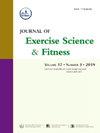Temporal trends in physical fitness among preschoolers from Macao Special Administrative Region between 2002 and 2020
IF 2.4
2区 医学
Q2 SPORT SCIENCES
引用次数: 0
Abstract
Objective
This study examined temporal trends in physical fitness among preschool children aged 3–5 years from the Macao Special Administrative Region, China between 2002 and 2020.
Methods
Representative repeated cross-sectional physical fitness data were collected in 2002, 2005, 2010, 2015, and 2020 (n = 4514). Body size (height, weight, and chest, waist and hip circumferences) and physical fitness (2x10-m shuttle run, standing long jump, walking balance, two-leg continuous jump, overhead throw, and sit-and-reach) were objectively measured. Trends in means were calculated using general linear models. Models were adjusted for gender, age, height, and weight. Trends in distributional characteristics were calculated as the ratio of the coefficients of variation and described visually.
Results
We found significant but small increases in height, weight, and chest circumference (standardised effect size [ES] = 0.27–0.42), a significant moderate increase in hip circumference (ES = 0.59), and a negligible trend in waist circumference. Physical fitness trends were conflicting, with negligible to small declines in throwing (ES = −0.14) and balance (ES = −0.32) performance, and negligible to small improvements in other measures (ES = 0.19–0.34). We found negligible trends in distributional variability and differing trends in distributional asymmetry.
Conclusion
Overall, these findings suggest modest growth and development among Macao preschoolers over the past two decades. Our findings also highlight the importance of ongoing monitoring to support physical fitness and overall health in early childhood. Continuous screening and monitoring are crucial for identifying trends and informing future health initiatives.
2002 - 2020年澳门特别行政区学龄前儿童体质变化趋势
目的研究2002 ~ 2020年澳门3 ~ 5岁学龄前儿童体质变化趋势。方法收集2002年、2005年、2010年、2015年和2020年有代表性的重复横断面体质数据(n = 4514)。客观测量体型(身高、体重、胸围、腰围、臀围)和体质(2 × 10米穿梭跑、立定跳远、行走平衡、两腿连续跳远、头顶投掷、坐伸)。使用一般线性模型计算平均值的趋势。模型根据性别、年龄、身高和体重进行了调整。分布特征的趋势以变异系数之比计算,并以视觉方式描述。结果我们发现身高、体重和胸围有显著但较小的增加(标准化效应量[ES] = 0.27-0.42),臀围有显著的中度增加(ES = 0.59),腰围的趋势可以忽略不计。身体健康趋势是相互矛盾的,投掷(ES = - 0.14)和平衡(ES = - 0.32)成绩的下降可以忽略不计,其他指标的改善可以忽略不计(ES = 0.19-0.34)。我们发现分布变异性的趋势可以忽略不计,分布不对称的趋势也不同。总的来说,这些发现表明澳门学龄前儿童在过去二十年中有适度的增长和发展。我们的研究结果还强调了持续监测的重要性,以支持幼儿期的身体健康和整体健康。持续的筛查和监测对于确定趋势和为今后的卫生举措提供信息至关重要。
本文章由计算机程序翻译,如有差异,请以英文原文为准。
求助全文
约1分钟内获得全文
求助全文
来源期刊
CiteScore
5.10
自引率
3.60%
发文量
54
审稿时长
31 days
期刊介绍:
The Journal of Exercise Science and Fitness is the official peer-reviewed journal of The Society of Chinese Scholars on Exercise Physiology and Fitness (SCSEPF), the Physical Fitness Association of Hong Kong, China (HKPFA), and the Hong Kong Association of Sports Medicine and Sports Science (HKASMSS). It is published twice a year, in June and December, by Elsevier.
The Journal accepts original investigations, comprehensive reviews, case studies and short communications on current topics in exercise science, physical fitness and physical education.

 求助内容:
求助内容: 应助结果提醒方式:
应助结果提醒方式:


